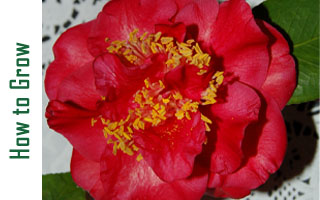Camellia Terms
Japonica: one of the most well-known species of Camellias. Originally from mainland China, Taiwan, southern Korea, and southern Japan.
Reticulata: a species of Camellia native to southwestern China, with usually large, loose blooms.
Hybrid: a cross between multiple Camellia species.
Sasanqua: a species of Camellia native to southern Japan, usually shrubby, and with varying petal types.
Miniatures: blooms that are 2 1/2 inches or less in size.
Seedlings: blooms from a non-registered variety of Camellia that is unique from previously registered varieties.
Mutants: blooms from a plant of an established variety of Camellia, that differ from the standard look of that
variety’s blooms.
Unprotected: Camellias grown outside, not in a greenhouse.
Untreated: Camellias grown naturally, without the use of gibberellic acid.
Treated: A bloom that has been treated with gibberellic acid (called gibbing).
Gibbing: The technique of applying gibberellic acid to a bloom to induce growing and size.
